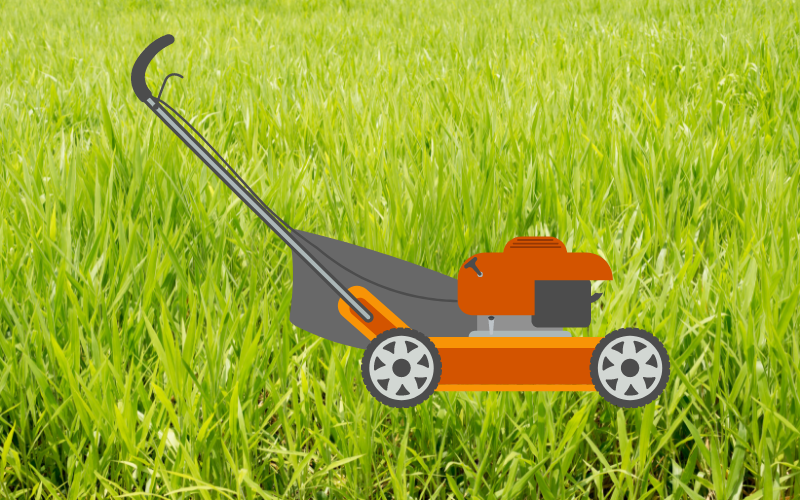Mowing annual ryegrass should be quick and painless. It goes dormant very easily for most of the year and requires no mowing at all. The only time you’ll need to expend much effort is when you need to cut your annual ryegrass back during the early to late spring if you intend to do so that year. However, mowing annual ryegrass to the right height and cutting it back in just the right way is not optional if you want to keep your lawn looking lush.

The Perfect Annual Ryegrass Mowing Height
Like most grasses, including perennial ryegrass, the perfect annual ryegrass height is 3”. However, depending on your local climate and other factors, you may want to adjust that height to a slightly higher 4”. However, annual ryegrass should never be mown shorter than 2.5” unless you intend to eliminate it from your lawn.
When to Cut Annual Ryegrass (First Cut + Last Cut)
If you want your annual ryegrass to stick around or you are using it as a primary grass:
Annual ryegrass should be mown when the grass grows higher than your desired height or a max of 4”, whichever comes first. For a first cut of the year, you want to wait until your lawn is no longer dormant and has grown at least 1/2” and, ideally, 1 full inch.
For the last cut, you want to wait until 3 weeks before your lawn will enter its dormant period. This means whenever temperatures fall below 45F consistently. While it would be easier if we could say “early Fall” or “late Fall”, measuring by season instead of temperature can give you uneven results and may even result in the accidental injury or death of your annual ryegrass- something completely avoidable. This is also true with perennial ryegrass.
You don’t want to cut annual ryegrass when temperatures or growth rate indicate dormancy. For annual ryegrass, any period greater than 4 days where temperatures are consistently above 90F or below 45F is likely to result in dormancy. During a period of dormancy, your grass is unlikely to grow at all or will grow at a rate of as little as 1/4” per month, with access to enough food, sun, and water. Annual ryegrass should never be mown while dormant as doing so may deprive the plant of necessary stored nutrients and result in death.
If you are using your annual ryegrass temporarily or as an overseed for warm-season grasses:
Follow the above advice until early spring. Two to three weeks before your warm-season or primary grass comes out of dormancy, start mowing your annual ryegrass to a height of 1.5” to 2”. This will help discourage it from sticking around and will allow your primary grass type to easily overtake it.
When to Adjust the Height of Your Annual Ryegrass
There is no single height your annual ryegrass should be. Knowing when and how high to cut your annual ryegrass, depending on climate conditions, is key to keeping your annual ryegrass looking its best.
For example, in perfect weather with plenty of rain or the ability to keep your ryegrass watered as it should be your mowing height will be 2.5” to 3”. If, however, temperatures are 80F to 90F or even 70F with drought conditions, you will want your annual ryegrass to be 3” to 4” tall so it can retain as much moisture as possible. This is how you can keep your annual ryegrass lawn green and alive during high heat and temporary drought conditions.
How Often to Mow Annual Ryegrass
Annual ryegrass should be mown when its height and growth rate indicate that it should be mown. This means that the grass is not dormant, is growing, and is taller than 3” in non-drought conditions. In practice, this typically means that annual ryegrass is mown every week to every other week for 2 to 4 months each year, splitting this time between late spring and early autumn.
Other Tips When Mowing Annual Ryegrass
When mowing annual ryegrass, it’s important to note that annual ryegrass is not generally meant to be used as a primary lawn grass. After as few as 3 years or growing seasons, an annual ryegrass lawn tends to be weedy, include at least 1 other grass species, and will appear coarse and seem like it’s full of stems instead of blades of grass. This makes it decent for overseeding if you must or as a stop-gap but not great as a primary choice.
You may also find that your primary choice, when mixed with annual ryegrass, looks less healthy than it did before mixing in the ryegrass. This is often due to allelopathy or the tendency of some plants (like annual ryegrass) to chemically signal to other plants (including grasses) that they should “back off”. This is the major con of overseeding with ryegrass.
Cut Your Annual Ryegrass Grass Back Hard Every Other Year
Due to all of the conditions mentioned above, it’s ideal if you “cut back” your annual ryegrass every other year and reseed with new seeds to start the cycle over again, even if annual ryegrass is your primary choice.
Sharpen Your Blades Before Mowing Ryegrass
Always use sharp blades on young ryegrass as dull blades can rip new annual ryegrass right out of the ground. Though annual ryegrass establishes quickly, the blades can tend to grow faster than the roots. Sharpening your blades each year before the first cut and again at the peak of summer is ideal for any lawn but can make an especially big difference for ryegrass.


Leave a Reply